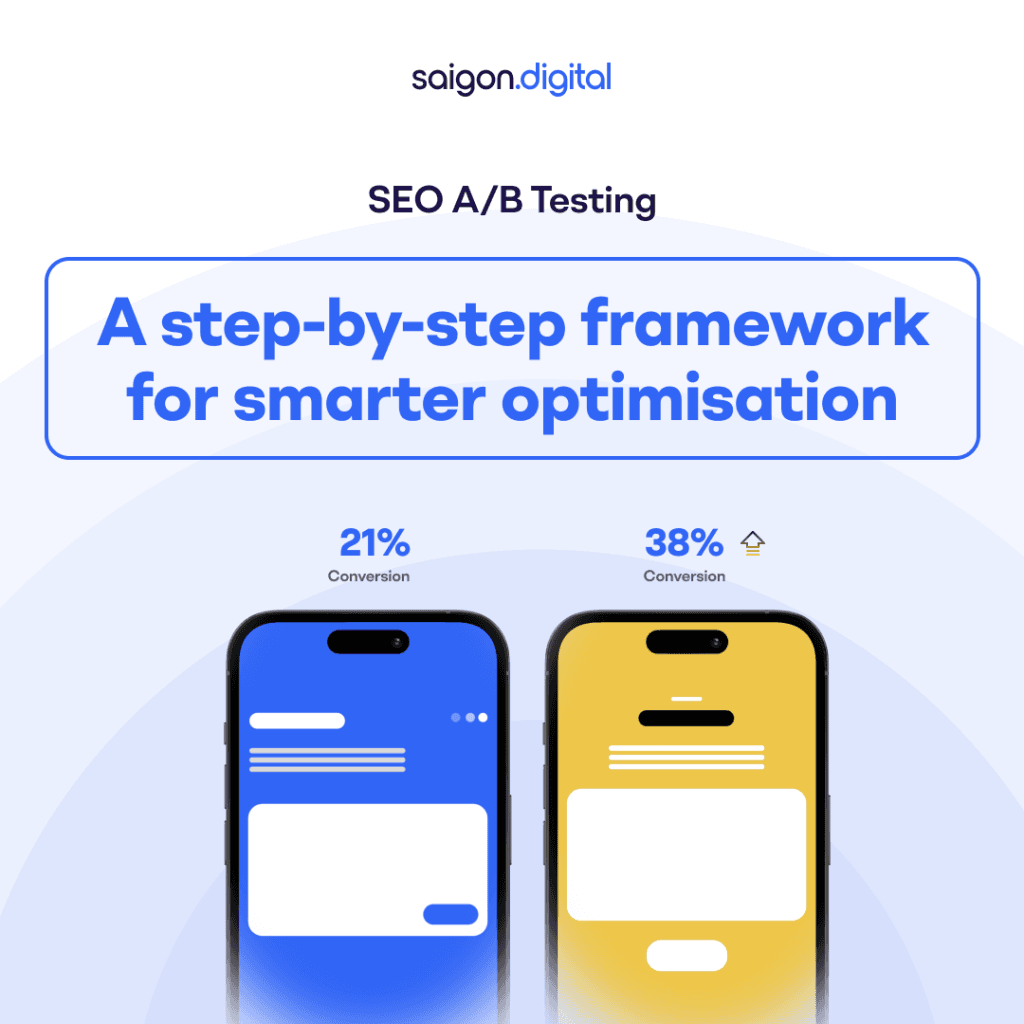
What Is SEO A/B Testing?
In conventional A/B testing (common in CRO or UI design ), you split users between two (or more) versions of a page or element, and observe how user behaviour differs (e.g. conversion rate, click-throughs). In SEO A/B testing, the aim is a little different: you want to measure how search engines (especially Google) respond to changes you make in terms of rankings, impressions, clicks, and organic traffic. But because search engines cache and index content slowly and apply global ranking algorithms, SEO tests must be designed carefully. Instead of splitting users, SEO tests typically split pages (or sets of pages) into control and variant groups which means, you apply your changes to some pages (the variant group) and leave others unchanged (the control group), then compare how their organic performance evolves over time.Key Principles and Best Practices Before You Begin
Before launching your first SEO experiment, keep these guiding principles in mind for they help ensure your tests are valid, safe for your SEO, and interpretable.1. Avoid Cloaking or Hidden Content
Do not show one version to search engine crawlers and a different version to users. That is considered cloaking and can be penalised.2. Use Canonical or 302 as Appropriate
If you use alternate URLs for variants, ensure you use rel="canonical" pointing to the original (control) URL. Also favour using 302 (temporary) redirects (not 301) during tests so as not to permanently divert link equity.3. Pages to Test Should Be Similar in Template and Intent
It’s best to test changes on pages that are alike (e.g. product pages, category pages, blog posts) so that your testing effect isn’t swamped by confounding variables.4. Randomise by Page
Because Google’s indexing is slow and ranking signals evolve, you generally cannot randomise on a per-user or time basis (e.g. switching that flips daily). Instead, you assign pages to either control or variant, once and for the duration of the test.5. Ensure Balanced Groups and Control For Bias
Avoid skewed buckets. For example, if one page in your variant group is your flagship blog drawing most traffic, that may dominate results. Use stratified sampling or pre-test balance checks.6. Run For a Sufficiently Long Time, and Pause After Significance
SEO changes take time to surface. Don’t rush. But don’t leave tests running indefinitely. When you reach statistical confidence or diminishing returns, conclude the test and act on results.7. Document Everything
Record hypotheses, test groups, expected lifts, dates, versions, and unexpected events (e.g. site migrations, algorithm updates). Good record-keeping is essential to learn over time. With those guardrails in place, let's turn to a robust, step-by-step framework for running SEO A/B tests.A Step-by-Step Framework for Smarter SEO A/B Testing
Below is a structured framework you can adopt at Saigon Digital and for your clients. You can adapt it depending on site size, traffic, and technical constraints. Phase Steps Details and Tips 1. Ideation and Hypothesis a) Audit and data gathering b) Prioritise ideas Use analytics, Google Search Console, heatmaps, site logs, internal search data to identify pages with underperformance (CTR drops, ranking volatility, low impressions). From these, generate hypotheses (e.g. “Adding keyword-rich modifiers to the title will raise click-through by 5%”). Score each idea by expected impact, confidence, and ease of implementation. 2. Select Test Region and Pages a) Define sample size / group size b) Bucket assignment Choose a set of pages that match your template/intent. Divide them into control and variant groups. Use stratified sampling to balance traffic, keyword distributions, historical trends, etc. The larger and more evenly balanced your groups, the more reliable your results. 3. Create Variant(s) a) Implement change(s) on variant pages only b) Ensure consistency and version control Make the SEO change(s) you wish to test (e.g. title tag rewrite, adding structured data , adjusting H2s, internal link adjustments, content tweaks). Keep variant and control pages consistent in all other respects to isolate the effect. Use version control or staging to manage changes. 4. Launch and Monitor a) Activate the test for a predetermined duration b) Monitor for anomalies Start the test and closely monitor indexing, Google Search Console warnings, crawl errors, or crawling issues. Ensure variant pages are being crawled. Watch for external events (site changes, global algorithm updates) that might affect data integrity. 5. Gather and Analyse Data a) Collect metrics over time b) Run statistical tests / confidence checks For each page in both groups, track metrics such as impressions, clicks, CTR, average ranking, organic traffic. Compare trends and compute relative lifts. Apply statistical significance tests (e.g. t-tests, chi-squared) or use software that handles experiment analysis. Check that results are not driven by outliers or bias. 6. Declare Winner and Decide Next Step a) Decide whether variant is winning, neutral, or losing b) Plan rollout or rollback If variant shows a meaningful positive lift at acceptable confidence, roll it out site-wide (while observing safely). If result is neutral, you may rework the hypothesis and test again. If variant is negative, roll it back. Document the decision and reasoning. 7. Iterate and Scale a) Use insights to generate new tests b) Build a backlog and maintain momentum Consolidate learnings. For tests that win, you can try derivative changes. For areas that underperformed, analyse why and pivot. Maintain a roadmap of SEO experiments, and aim for regular test cadence rather than sporadic efforts. Let’s unpack a few phases with deeper nuance.1. Ideation and Hypothesis
One of the most valuable parts of an SEO testing programme is good ideas. Data sources you should consult include:- Google Search Console: pages with high impressions but low CTR (indicates possibility of better titles/meta).
- Ranking drop alerts or volatility: pages whose positions fluctuate frequently.
- Internal site search, bounce rates, user engagement metrics: to spot content gaps.
- Competitive / SERP analysis: see what related pages rank above yours, and what elements they include.
2. Sample / Bucketing
One challenge in SEO A/B testing is ensuring balance between control and variant groups. Some pages may inherently dominate traffic, and if they go into one group, results become skewed. Use stratified sampling (grouping pages by traffic, impressions, keywords) to distribute strong and weak pages evenly. Some platforms or custom scripts can help you simulate various bucket assignments and check for balance.3. Variant Construction
Avoid drastic changes or “all in one” experiments if possible — smaller, incremental changes are safer and easier to interpret. Examples of testable elements:- Title / meta description modifications
- H1 / H2 adjustments
- Internal linking changes
- Structured data (JSON-LD) additions
- Content reordering or augmentation
- Image alt text optimisation or image compression
- Canonical tags or rel=“next/prev” tweaks
- URL parameter handling or pagination tweaks
- Robots or crawl directives (with caution)
4. Monitoring and Guardrail Checks
While the test runs, continuously monitor:- Crawling / indexing status in Search Console
- Any 404s, server errors, page-level issues
- Unexpected traffic spikes or drops across control / variant
- Any wider site changes (CMS migrations, algorithm updates) that might confound your test
- Early signs of negative SEO impact (e.g. variant pages losing rank drastically)
5. Data and Statistical Analysis
Accumulating data over time is crucial. Because web traffic often has seasonality, week-on-week variation, etc., don't rely only on early results. Once you have a reasonable dataset (weeks or even months depending on site scale), perform the statistical test of your choice. Many SEO testing tools provide built-in significance engines. Also examine the distribution of results across pages, avoid being misled by one outlier page. Consider checking the median uplift, not just mean.6. Decide and Roll Out
When you reach your confidence threshold, choose your action:- Variant wins → roll it out more broadly or site-wide (with fallback / monitoring).
- Neutral → retrace, refine hypothesis, or stop for now.
- Losing → rollback to control version, document observations, and avoid repeating that change (unless heavily revised).
7. Iterate and Build a Culture of Experimentation
SEO A/B testing is not a one-off. Build a posture of continuous learning:- Keep a test backlog: ranking performance, content gaps, CTR opportunities.
- Rotate test types (not always titles or meta, try structural, linking, crawl experiments) so you learn across dimensions.
- Maintain a knowledge repository of hypotheses, results, wins, failures, and lessons.
- Integrate SEO tests into your overall digital experimentation programme (if you also run CRO / UX testing) and flag interactions between SEO and conversion goals.





